It’s monsoon season in India, rainy season in Miami. I’m saying it’s really wet. Chana masala is just the ticket. Chana masala, or curried chickpeas, is high in protein and fiber, big in flavor, and naturally plantbased. It’s a standard on Indian takeaway menus, but chana masala is also a snap to make at home with pantry staples. It’s soothing and spiced, but not spicy (unless you want it to be).
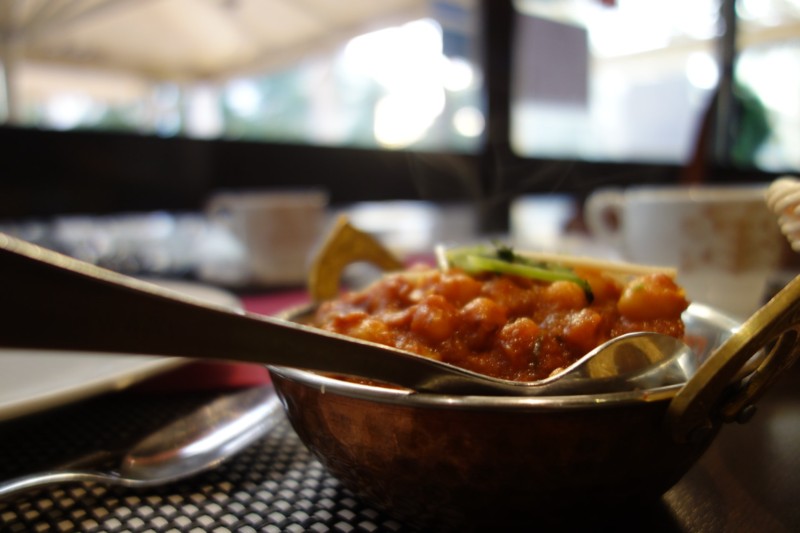
Chana needs:
- chickpeas (tinned or dried and cooked from scratch)
- tomatoes (tinned are fine)
- a symphony of warming spices
Gentle, slow cooking guarantees the chana, the Hindi word for chickpeas, will be tender and infused with rich flavors in the sauce. The spice level can be dialed up or down.
The hottest chana masala I ever had was years ago, at a little neighborhood Indian restaurant back when we lived in Tokyo. I kept asking the chef to make it hotter and hotter. God knows what he thought of crazy American girl, but he listened — and he delivered. Our favorite waiter called them napalm. I loved them.
Chana masala doesn’t need to be chile-hot, but it should be warming from cumin, ginger, turmeric, and a little cayenne. It should also have a little bit of tartness.
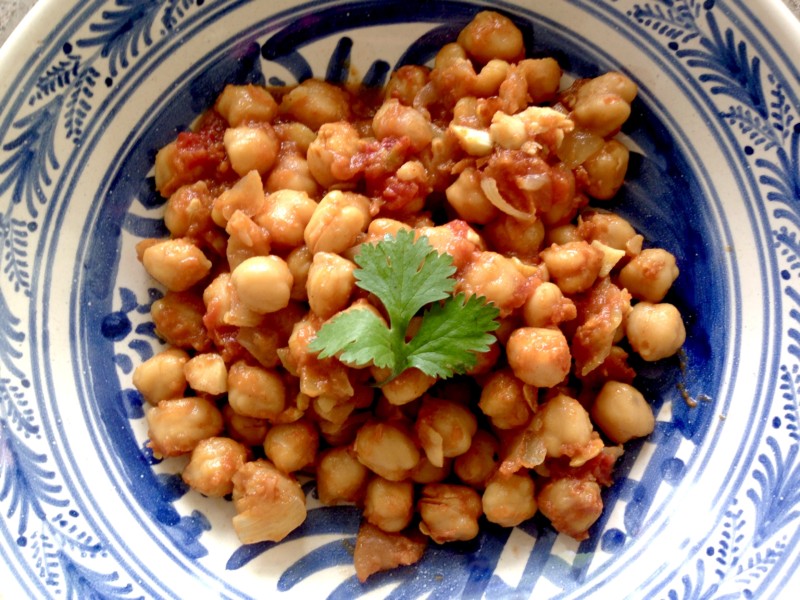
Recipe Tips and Extras
You know I’m a huge fan on seasonal produce, but sometimes being able to grab and go with what’s in your pantry is a lifesaver. You probably have these spices on hand:
- cumin
- turmeric
- coriander
- cayenne
- paprika
If not, stock up!
My granny would have considered these spices “exotic.” Now they’re in your grocery store, and frankly, I couldn’t cook without them.
Two ingredients may be harder to find, though:
- amchoor — Dried mango powder. Anything mango you’d think would be sweet, but amchoor is made from green, underripe mango. It’s mouth-puckeringly tart. If you don’t have it, substitute a tablespoon of fresh lemon juice.
- curry leaves — You probably know curry as a spice blend or a spiced stew from India, Asia or the Caribbean, Thailand. but curry is also— surprise! — a tree. A member of the citrus family, curry leaf isn’t spicy, but has a haunting low note,, it adds an elusive but elemental dimension to every Indian dal, Thai red curry, or other curry you love.
You can find amchoor powder and frozen curry leaves in Indian markets, or other specialty markets. But don’t struggle. Making this without them may not hit all the high and low notes but it’ll still be singing the same cbeery chana song.
Chana masala is a basic recipe that invites tinkering. The sultry summer rains made me crave extra ginger. Not a chile-head? Use less serrano, or skip it. If you like it hot like me, you can always spice up your own serving. The thing is you can always add more chile. Taking it out is harder — but not impossible.
Recipe Rescue — How to fix a sauce or stew when there’s too much chile or salt
Slice up a raw potato. Slide the slices into the sauce. Simmer the sauce for about 20 minutes on low heat. Being porous, the potato will soak up the dominant flavors. Taste the sauce, adjust the seasoning and discard the potato (unless it’s so tender and delicious now, you want to keep it).
How to make:
- Heat oil in a large soup pot over medium-high heat. Add chopped onions and minced garlic and ginger. Add minced serrano or other chile if desired.
- Cook, stirring, for about 10 minutes, or until the vegetables soften and turn into a golden paste.
- Stir in coriander, cumin, cayenne, turmeric and paprika.
- Add tomatoes, cinnamon stick, amchoor or lemon juice. Stir together to combine.
- Stir in chickpeas and 1/2 cup of chickpea broth, vegetable broth or water. Reduce heat to low.
- Cover and simmer for 20 minutes. Remove cover and give mixture a stir. The sauce should be thick enough to coat the chickpeas. If it seems too soupy for you, continue cooking, uncovered for another 5 minutes or so.
- Season, garnish, and serve.
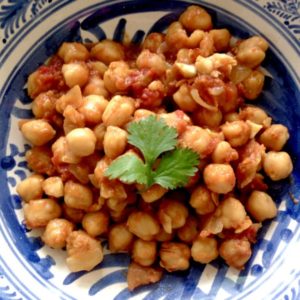
Chana Masala
Ingredients
- 2 tablespoons grapeseed or coconut oil
- 1 medium onion chopped
- 3 cloves garlic minced
- 1- inch piece of ginger minced
- 1 serrano minced (optional but terrific)
- 1 tablespoon cumin
- 1 tablespoon coriander
- 1/2 teaspoon ground cayenne
- 1 teaspoon turmeric
- 1 tablespoon amchoor or the juice of 1 lemon
- 2 teaspoons paprika
- 2 tomatoes chopped or 1 15-ounce can tomatoes
- 1 cinnamon stick
- 4 cups home-cooked chickpeas or 2 15-ounce cans chickpeas plus reserved chickpea broth
- sea salt and freshly ground pepper to taste
- optional garnish – a handful fresh coriander chopped coriander and/or a 2-inch piece of fresh ginger, chopped into matchsticks
Instructions
- Heat oil in a large soup pot over medium-high heat. Add chopped onions and minced garlic and ginger. Add minced serrano, if desired.
- Cook, stirring, for about 10 minutes, or until the vegetables soften and turn into a golden paste.
- Stir in coriander, cumin, cayenne, turmeric and paprika.
- Add tomatoes, cinnamon stick, amchoor or lemon juice. Stir together to combine.
- Stir in chickpeas and 1/2 cup of chickpea broth, vegetable broth or water. Reduce heat to low.
- Cover and simmer for 20 minutes. Remove cover and give mixture a stir. The sauce should be thick enough to coat the chickpeas. If it seems too soupy, continue cooking, uncovered for another 5 minutes or so.
- Season with sea salt and freshly ground pepper, add chopped coriander or ginger, if desired, and serve.
More Indian inspiration:
Tandoori vegetables, no tandoor — or Indian clay oven — required.
Kitchri rice and lentils get the glory they’re due. Soulful, spiced, easily digestible and deeply nourishing, this is a dish that’s been fed to babies and new mothers for generations.
Mango Curry (also in my book, Feeding the Hungry Ghost, where it appears as Mango Madness)
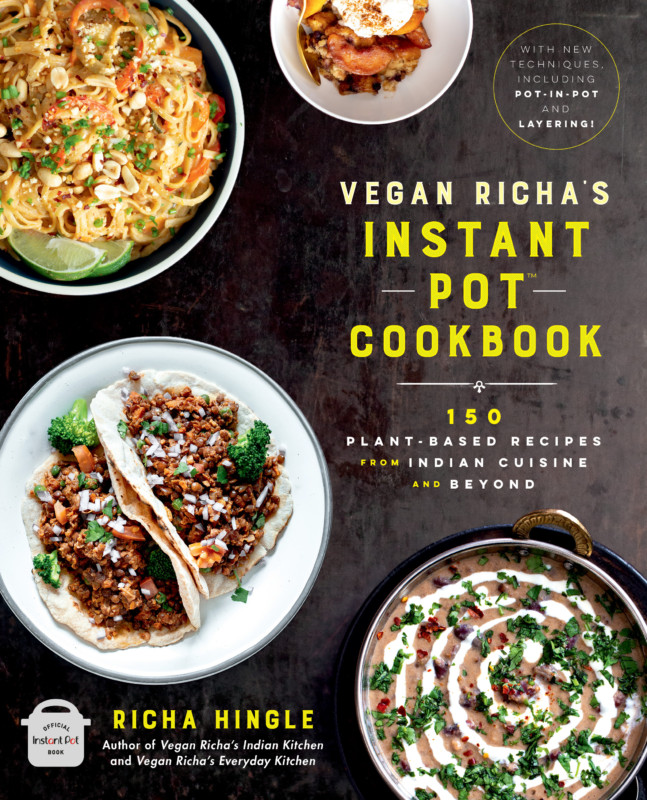
Vegan Richa shares her recipe for masala lentils sabut masoor. While you’re at it, check out her new book, Vegan Richa’s Instant Pot Cookbook. With do-it-fast dishes like dum aloo — potatoes cooked in a creamy tomato sauce. You’re welcome.
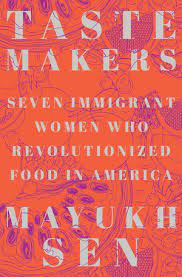
Julie Sahni, profiled in Mayukh Sen’s Taste Makers: Seven Immigrant Women Who Revolutionized Food in America, has written a wealth of Indian cookbooks. Her warm manner coupled with the techniques she shares coax you into the kitchen, and her recipes, though not all vegan, are sumptuous,
Finally, I can’t write about Indian cuisine without a shout-out to Madhur Jaffrey. You may know her as an actress, but she’s also India’s ambassador, interpreting Indian cuisine for an American audience with over 30 cookbooks. If you’re unsure where to begin, there’s no better source. When Jaffrey started cooking, “I knew absolutely nothing.”

Leave a Reply